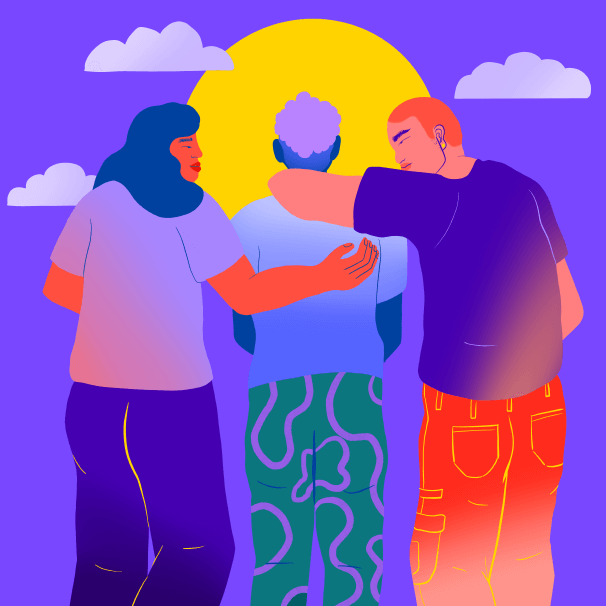It’s totally normal to have questions about HIV/AIDS, whether if you are having sex, thinking about having sex, or are just curious. No matter the reason, it’s important to educate yourself because HIV/AIDS affects people of all ages, sexual orientations and identities.
HIV, also known as Human Immunodeficiency Virus, is a virus that affects, and ultimately destroys your body’s immune system. When this happens, it’s much harder to fight off other infections and diseases, leaving you vulnerable to illness. Something like the common cold or the flu could have fatal consequences for someone living with HIV.
AIDS, which stands for Acquired Immunodeficiency Syndrome, can also develop in someone living with HIV. If someone has AIDS, it usually means that they have a more advanced stage of the disease. Many people with AIDS have also been diagnosed with other infections as a result of their weakened immune system, and their body remains vulnerable to catching others.
Both HIV and AIDS affect people of all ages, sexual orientations and identities. According to the CDC, almost 8,000 youth aged 13-24 in the United States were diagnosed with HIV in 2018, accounting for about 21 percent of all new HIV diagnoses. There isn’t a ton of routine testing for young people, so it’s quite possible a lot of young people who are HIV-positive don’t know their status; the CDC estimates that only 56 percent of HIV-positive youth know their HIV status. There also isn’t a lot of research about the HIV status of trans and non-binary folks, particularly young people. HIV/AIDS continues to affect people for a lot of reasons, including a lack of comprehensive sex education in schools; ongoing fear, misunderstanding of, and stigma against HIV; and unstable access to sexual healthcare.
HIV is spread through bodily fluids — including blood, semen, penile or vaginal secretions, or breast milk — and is most often spread through sexual intercourse. It can also be transmitted through injection drug use, needlesticks, or blood transfusions or from a parent to child, either in the womb or through breast- or chestfeeding.
Treatment for HIV usually involves regular check-ups with your doctor, who may prescribe you medications to control the virus, protect your immune system, and delay the progression to AIDS for as long as possible. By taking medication consistently and as prescribed, it’s possible to reduce the level of the virus in your bloodstream to undetectable levels, which means that it becomes virtually impossible to infect your sexual partners and other people in your life. There is currently no cure for either HIV or AIDS.
In order to prevent yourself from contracting HIV, it’s important to get tested regularly. By knowing your HIV status, you can ensure your own health and better prevent the spread to others. You should also talk to your partner(s) about the last time that they were tested.
If you’re having sexual intercourse with people of any gender or sexuality, latex barriers — including outside condoms, inside condoms, or dental dams — are very effective at reducing the risk of HIV transmission and other sexually transmitted infections (STIs).
In order for condoms to be most effective, it’s important to use them correctly, which means during all direct contact with genitals, including anal and vaginal intercourse, as well as oral sex. It also means opening the condom package carefully and using latex-safe lubricant to avoid tearing the condom itself. If you’re using an outside, penile condom, leave room at the tip for fluids to gather and being sure to hold the base of the condom when withdrawing after sex.
There are other harm reduction techniques when it comes to sex, including limiting the number of sexual partners you engage with, and avoiding or limiting drug and alcohol use, which could affect your decision-making during sexual situations. There are also plenty of sexual acts that have zero to no risk for HIV transmission, which include kissing, petting, frottage, manual sex (like handjobs and fingering — as long as your hands are clean), and mutual masturbation.
If you are currently using injection drugs, you can reduce harm by not sharing our reusing your equipment. You can also research local syringe or needle exchange programs available in your area that distribute sterile injection drug-use equipment like needles, syringes, cookers, or cotton filters. These programs are safe, anonymous, and a free way for you to practice harm reduction and dispose of used needles.
There are also medications to help prevent you from contracting HIV. The first is Post-Exposure Prophylaxis (sometimes called PEP or nPEP for short), which is a treatment for people who have been potentially exposed to the HIV virus. PEP is typically taken for 30 days and must be started within a few hours — and up to 72 hours — after exposure.
Pre-Exposure Prophylaxis, which is also known as PrEP, is a daily medication that can reduce the risk of contracting HIV by as much as 99 percent. PrEP is a good option for folks who are at risk of contracting HIV, including those whose partners are HIV-positive or whose HIV status is unknown. Since it doesn’t protect against other sexually transmitted infections (STIs) or pregnancy, PrEP is not a replacement for all safer sex practices. A great thing about PrEP is that it doesn’t require cooperation from sex parnters, so it’s in your control to be proactive with your own health.
There are plenty of people ready to support you as you take steps to take care of yourself and other folks in your life. If you have questions about HIV/AIDS, you can speak to a trusted healthcare provider, if you have one. The crisis counselors on TrevorChat, TrevorText, and TrevorLifeline are also here for you 24/7.
Here are some helpful resources on HIV/AIDS. Remember, you can always call the Trevor Lifeline if you need immediate help or support.
For AIDS and HIV specific hotlines, please check out:
Resources
- AIDS.gov – HIV/AIDS Basics
- AVERT – About HIV & AIDS
- TeenHelp – HIV & AIDS
- TeenSource – HIV/AIDS
- The Body – United States AIDS Hotlines
- CDC – Resources for People Living with HIV
- CDC – Get Tested
- AIDS.gov – Testing Site Locator
- HRSA – Get HIV Care and Treatment
Through The Trevor Support Center you are able to link to other websites which are not under the control of The Trevor Project. The Trevor Project does not review or ensure the accuracy of the content on other sites.
Help us continue to provide 24/7 support to LGBTQ+ young people and empower allies to deepen their commitment through advocacy, education, and affirming content.


